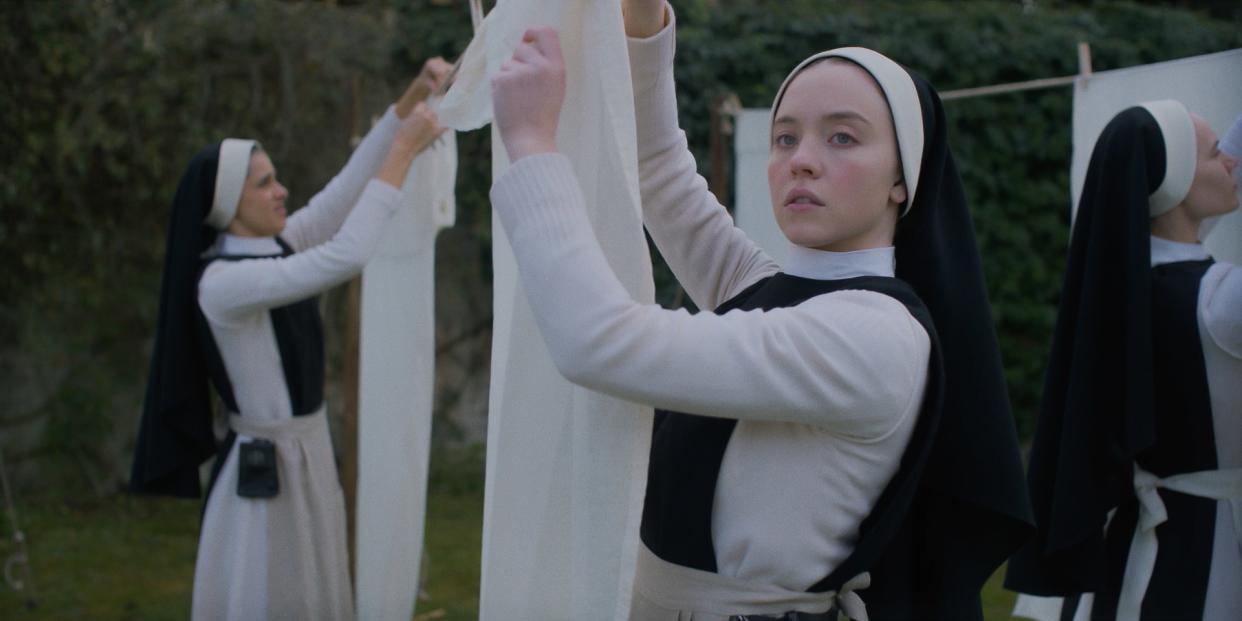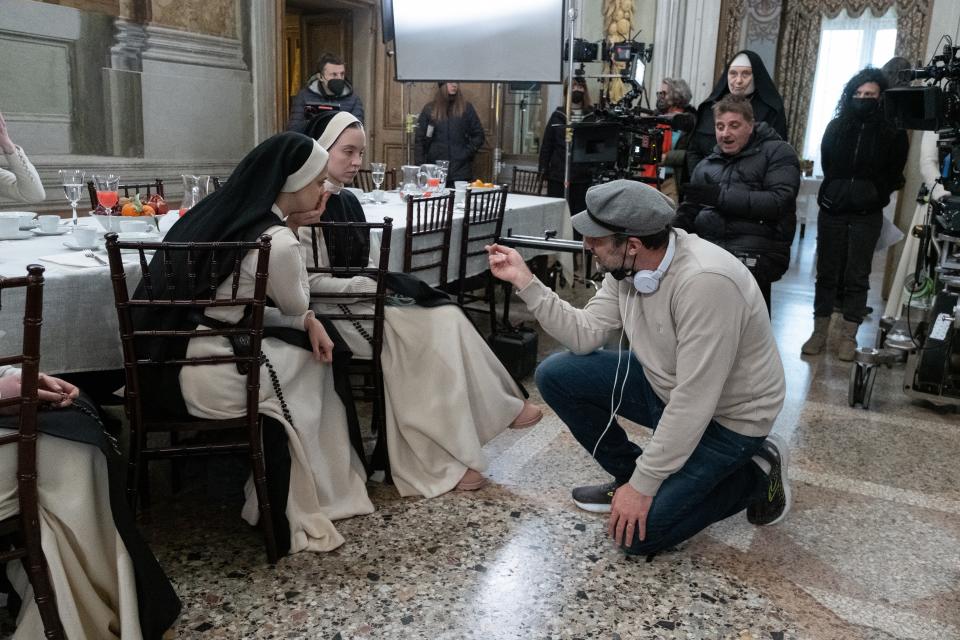‘Immaculate’ Just Gave Us the Most Intense Scene of Sydney Sweeney’s Career

- Oops!Something went wrong.Please try again later.
Courtesy of NEON
This story contains major spoilers for Immaculate, including the ending.
When Sydney Sweeney first approached Michael Mohan about directing Immaculate, the actress had one primary request: “At the end of this movie, I just want to be covered head to toe in blood,” Mohan remembers her telling him. “I want my Carrie moment.”
Mohan took her words to heart.
The 89-minute Catholic-horror movie, which hit theaters over the weekend, borrows from Rosemary’s Baby and The Exorcist and is chock full of fun and familiar religious tropes—spooky priests, spectral images, and creepy confessions. It follows Cecilia (Sweeney), a nun in training who moves from Michigan to a remote Italian convent. Not long into her stay, she becomes pregnant, despite claiming to be a virgin. This revelation (deemed a miracle by most everyone around her) sends Cecilia down a dangerous conspiratorial rabbit hole, ultimately leading to the movie’s visceral and, yes, blood-soaked final minutes. Let’s break it down.
At the conclusion of Immaculate, Cecilia discovers that the baby inside her is (shocker) not the work of God, but a clergy-sanctioned, nonconsensual insemination experiment, one that involves Jesus’s genetic strands that have been scraped from the rusted nail used in his crucifixion. Imprisoned and on the cusp of giving birth, Cecilia retaliates. She bludgeons her Mother Superior (Dora Romano) with a bedside crucifix, strangles the complicit Cardinal Merola (Giorigio Colangeli) with a rosary, and then, after setting fire to his underground laboratory, stabs the sadistic Father Tedeschi (Álvaro Morte) with his holy nail. But her murder streak doesn’t end there. After escaping the convent’s maze-like catacombs, Cecilia squats down and begins delivering her (messianic?) child, screaming in pain before biting off the umbilical cord as it writhes on the ground. Then she picks up a large rock, raises it over her head, and—with one final and primal shriek—delivers a fatal blow.
It’s an electric, unnerving, and exasperating curtain drop, her raw and rage-filled roars belying the movie’s previous candlelit terrors. In line with his star’s wishes, Mohan splatters Sweeney’s face and clothes with blood, framing her maniacal expressions in one continuous close-up shot as she births—and then extinguishes—a breathing lifeform. You can feel her unleashing everything she has into one of the most memorable scenes of her young career. “It's all about building to this moment of catharsis for her,” Mohan says. “It's pain, it's anger, it's frustration, it's release, it's relief. It's just this explosion of intensity and it just felt right.”
Mohan began envisioning this infanticidal finale as soon as he signed onto the Sweeney-produced project. “Originally, this was a traditional studio movie, and so it had a much more conservative ending,” he says. “When I finished reading the script, I knew how the ending needed to be changed.” The flash of inspiration, he says, was born from his “really fucked up sense of humor,” but it also worked for the production’s tight shooting schedule throughout Italy. “I was really trying to cut out all the boring parts that you typically have to suffer through in horror movies,” Mohan says. “It's not a particularly showy one-er. It’s more about living with her performance.”

Immaculate
To pull it off, Mohan and his camera operators mapped out their location and rehearsed Cecilia’s movements (they shot near Rome in an area called Monterano), keeping her bloody infant just visible in the corner of the frame. Otherwise, Mohan refrained from giving notes, letting Sweeney (whom he worked with previously on The Voyeurs and Everything Sucks!) control the tempo and pace of the birthing scene. “I don't think we actually counted the number of times she would scream,” he says. “But she and I had talked about wanting to live in this moment for a significant portion of time.” To Mohan’s surprise, everyone nailed the first attempt (they filmed a few extra takes for good measure), which they later watched on the monitors in disbelief. “It just felt perfect,” he says. “What was in my head and what's on the screen was pretty much identical.”
Though Mohan ultimately leaves the mutated baby’s appearance abstracted and out of focus, the studio requested he film at least one close-up of Cecilia’s newborn in case test audiences didn’t embrace his audacious vision. He begrudgingly complied, respecting his financiers’ wishes. “We did craft an incredibly scary puppet that was controlled by a series of tubes that we buried in the ground,” Mohan admits. Ultimately, the director’s ambiguous ending won out, a decision he believes allows for more germane and varied interpretations and isn’t so “overtly campy.”
“Is it a demon baby? Is it a genetically malformed baby?” he asks. “In a movie that's dealing with such hot button issues, the goal is to inspire a discourse. And I think to show it would sort of squash that.”
So far, he says, early audiences have agreed. Still, finding the right reactions took some trial and error in the editing stage. Ahead of the first test screening, sound supervisor Bryan Parker inserted a distorted goat-bleating noise for when the baby plops to the ground. But in the theater, “audiences simply rejected it,” Mohan says. “It created laughter, but not the good kind of laughter.” Mixing in a few other elements, they eventually landed on the sound of a sick cat to replace it. “We added a little bit of warbling to make it sound like it's kind of choking or having a hard time breathing or is simply possessed,” Mohan laughs. “We spent a lot of time trying to find the perfect balance.”
As someone raised “super-duper Catholic” outside of Boston, Mohan found the whole experience cathartic himself. Cecilia’s anger, he says, helped him reconcile his own feelings about the church, allowing him to turn the movie into “this sort of beautiful, disgusting piece of art.” That would include the very end, when Cecilia delivers her rock-smashing deathblow. Is it a last-ditch way to vanquish evil? A metaphor surrounding late-term abortions? A righteous sacrifice? Mohan doesn’t want to suggest any specifics, but he does like one recent theory. “So many verses in the Bible talk about God as our rock that someone could actually view this as pro-Christianity, because she's using God to destroy evil,” Mohan says. “I just love when antagonists are killed in ways that contain poetic justice.”
Most of the credit for the scene’s success goes to Sweeney, though, who Mohan remembers being “downright giddy” to drench herself in blood and scream for a dozen takes if necessary. “This was her dream,” he says. “Going to these super intense places is kind of her superpower.” A few days later when production wrapped, Sweeney boarded a flight from Rome to Australia to begin shooting (and producing) her recent rom-com Anyone But You, a tonal whiplash most actors would gawk at.
“That’s the thing,” Mohan says. “This is really easy for her.”
Originally Appeared on GQ

